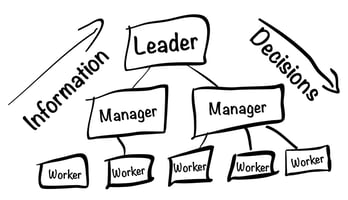Have you ever seen a bright, capable person become frustrated when the organization doesn’t make...
Leaders control themselves, not their people
Have you ever had an employee whose energy was focused not on what they do, but more on what others “had to” do? It happens to all of us sometimes.
Jenny (not her real name) had a direct report (“Ken”) who always had a reason why he couldn’t meet his goals, and that reason was that someone else in the company was blocking him, and he was powerless to prevent it. Jenny felt frustrated, because when Ken didn’t meet his goals, the whole team suffered. She was spending her own time managing or preventing the consequences of the work not getting done on time. It was becoming a problem.
Ken had become quite skilled at coming up with stories where other people were at fault, and Jenny was often intervening on Ken’s behalf. This was using up her precious time.
Working with Ken, she came to realize that she was contributing to the dynamic: by focusing on Ken’s problems, Jenny was making it easy for Ken not to. Instead she needed to set a clear boundary, making it clear who needed to own this problem, so Jenny could put more focus on the team’s success.
The next time Ken came to her with a reason for why he missed a goal (Ken blamed someone in another department; Jenny knew better). Jenny knew Ken should have been able to handle this on his own. Jenny recognized that when Ken came to her with a problem, her emotions were preventing her from making the best choice for the group. So the next time Ken tried and excuse for missing a goal, Jenny chose to expiriment with a new approach.
“That’s too bad. Now what do you think you’re going to do?” Jenny said to Ken.
Ken, non-plussed, was ready for this, and tried to hand his problem to Jenny again. “I don’t know! I can’t make them do it.”
Jenny held firm. “It’s going to be hard to hit your performance objectives without getting this done.” They spoke about how Ken felt when faced with confronting the situation, and Jenny gave him some pointers on dealing with his emotions. Jenny made sure Ken understood that she expected him to solve the problem, and that she was confident that he could do it.
Ken wasn’t happy with this situation, but what Jenny learned was that she couldn’t control Ken’s behavior: he could choose to do what he needed to do to meet his goals, or not. What Jenny could control was her own behavior: whether she enabled Ken’s underperforming by removing blockers for him, or focused her limited time on issues where she could make a bigger difference.
Leaders are often faced with choosing to rescue others from their situations, and helping your people is important. It’s important for leaders to recognize how their emotions are impacting their own decisions, and stay focused on what they themselves control.



